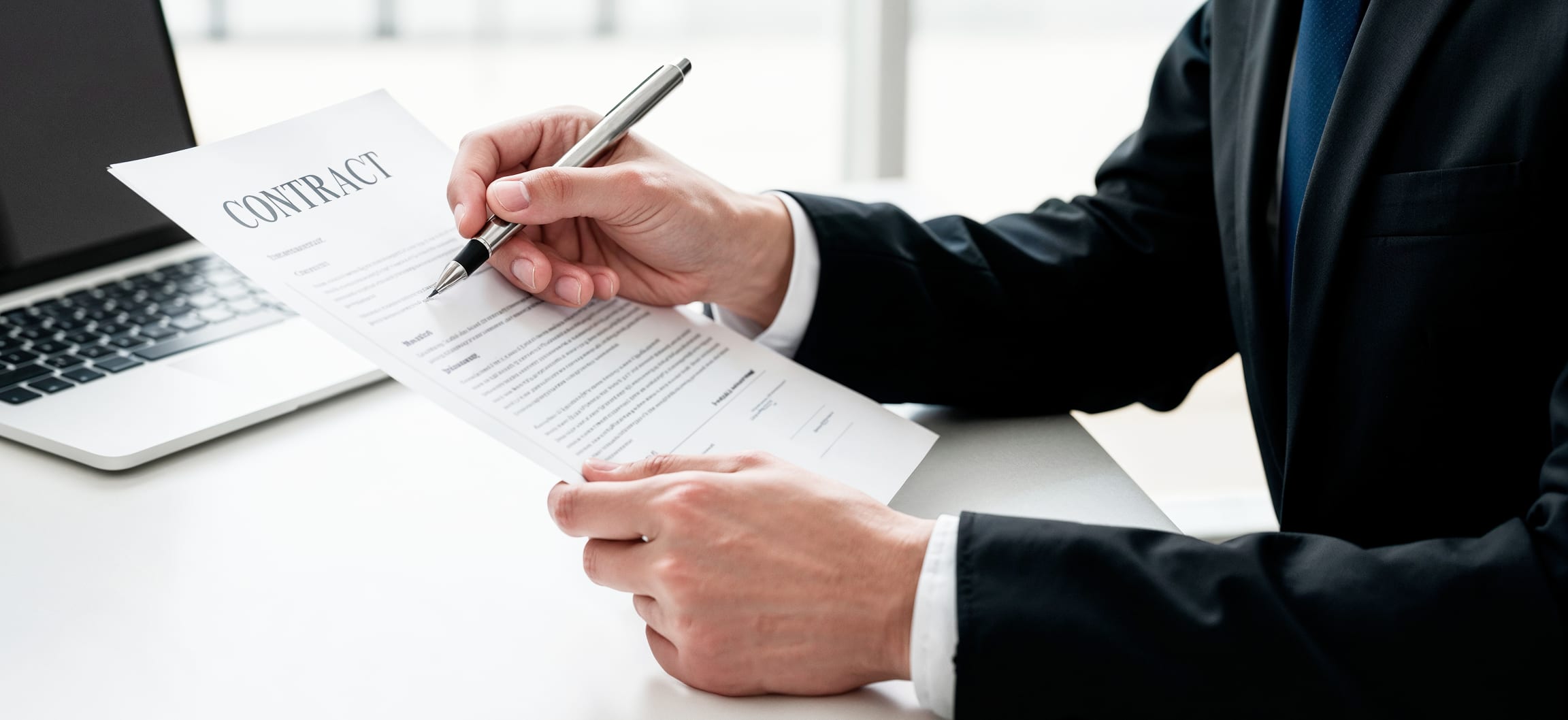
- Industries
Contact sales
Our software caters to all the verticles of equipment rental businesses. Have other plans? Share yours.
 Chat with us
Chat with us - Marketing Strategy
- SEO Guide
- Blog
Contact sales
Our software caters to all the verticles of equipment rental businesses. Have other plans? Share yours.
 Chat with us
Chat with usSteps to prepare the equipment rental agreement
Inside the article
Request a product demo
Get a demo and clarify your doubts about our software.
Renting out equipment comes with responsibilities and risks for both the owner and the renter.
The best way to ensure a smooth rental experience is to have a clear equipment rental agreement.
From explaining “what is an equipment rental agreement to creating one,” we have put everything in one place—I mean, this blog.
What is an equipment rental agreement?
To put it simply, the equipment rental agreement is a legal contract between the equipment owner (the lessor) and the renter (the lessee).
This document outlines all the terms and conditions of the rental.
In other words, it details who is renting what equipment, for how long, for how much, and under what conditions.
Once signed, neither party can alter the agreement without the other’s consent.
Why equipment rental agreement is essential?
Protects both parties
The agreements protect both parties by clearly defining expectations and responsibilities.
By talking about things like proper use, maintenance, and return conditions, you can avoid misunderstandings that can lead to conflicts.
Legal protection
The equipment rental agreement provides a formal, legal record of the arrangement.
It offers a layer of legal protection similar to insurance.
If something goes wrong, you have the contract to speak for you.
Clarity on liability
The accident or equipment failures are irresistible. The role of the agreement is to clarify who is responsible for repair costs or injuries.
A good rental agreement explicitly states what happens in scenarios like damage, theft, or malfunctions, so there are no surprises about who pays for what.
Professionalism and trust
Using a written agreement also signals professionalism.
It shows that you take the rental transaction seriously and run a reputable operation.
Conversely, renters feel more secure knowing their rights are documented in writing.
Key components of an equipment rental agreement
A good equipment rental agreement should cover all the essential terms of the rental.
While specific clauses can vary depending on the type of equipment, typically, a comprehensive agreement will include the following key components mentioned below.
- Party's information (Lessor & lessee)
- Equipment description
- Rental term (Duration)
- Rental fees and payment terms
- Security deposit
- Maintenance and repair
- Insurance requirements
- Liability and indemnification
- Usage restrictions
- Delivery and return conditions
- Default and termination
- Dispute resolution
- Governing law
- Ownership and title
- Signatures
Let’s start preparing your equipment rental agreement
Identify the parties involved
Start by writing down the full names and addresses of both parties. This includes the name of the equipment owner and the renters.
Mention these details at the top of the contract.
To show you the example: “This Agreement is between XYZ Rentals, Inc., located at 123 Main St, City, State, and John Doe of 456 Oak Ave, City, State.”
Describe the equipment in detail
Describe which equipment is being rented.
Include notable details such as the type of equipment, model, year, serial number, and condition.
If there are multiple items or accessories, note them all.
Being specific here prevents confusion later, and both parties should be crystal clear on what is being rented.
Define the rental term
Specify the start date and end date of the rental period.
Write out when the lessee will take possession of the equipment and when it must be returned.
If the time of day matters, include that as well.
Also, consider if you want to allow extensions. If so, outline how extension requests will work.
Outline the rental fees, deposit, and payment details
Clearly state how much the renter will pay and on what schedule.
Break it down:
- Rental rate: e.g., “$500 per day” or “$2,000 per week”, etc. Mention if tax is included or extra.
- Payment schedule: e.g,. “Full payment due upfront on signing,” or “50% deposit due on signing and remaining 50% due on the start date,” or “rent will be invoiced monthly.”
- Security deposit: If required, state the amount and when it must be paid. Explain that this deposit will be held and how/when it will be returned, minus any deductions for damage or late return.
- Late fees: Specify any penalties for late payments or late returns.
- Payment method: Note how payments should be made (bank transfer, credit card, check, etc.).
Set responsibilities for care, maintenance, and operation
Describe how the lessee should take care of the equipment during the rental.
Proper use
State that the equipment should be used only for its intended purpose.
You might reference an attached user manual or guidelines for operating the equipment safely.
Maintenance
Clarify who handles maintenance.
Typically, the lessee should perform basic care but should not attempt any major repairs.
Usually, they are responsible for routine maintenance to ensure the equipment is in good condition at the start.
Prohibited actions
Note anything the lessee must not do.
For instance, they should not sublease the equipment to someone else, not remove identification tags or serial numbers, and not make alterations to the equipment.
Notifications of issues
Require the lessee to notify the lessor immediately if the equipment breaks down or if any accident or damage occurs.
Return condition
Emphasize that the equipment should be returned in the same condition as it was provided, aside from normal wear and tear.
If it needs to be cleaned, mention that as well.
Address liability, damage, and insurance
Damage/theft responsibility
State that the lessee is responsible for any loss, theft, or damage to the equipment during the rental period.
You can instruct that any damage must be reported, and they will be liable for repair or replacement costs.
Liability for use
Clarify that the lessee assumes responsibility for any injuries or property damage that occur from using the equipment.
Essentially, the renter should use the equipment safely and is liable if something goes wrong due to misuse.
Insurance
If you require the lessee to have insurance, specify the type and amount.
You might require them to provide a certificate of insurance proving that the equipment is covered during the rental period.
If you (the lessor) provide insurance, explain what it covers (e.g., does it cover all damage, or is there a deductible?).
Include other key terms and clauses
Return logistics
Explain when and where the equipment will be returned.
For instance, “Lessee will return the equipment to Lessor’s warehouse at [address] on [End Date] by 6:00 PM.”
If the lessor is picking it up, write that and any scheduling details.
Cancellation policy
If either party can cancel the agreement before the rental starts, state the terms (e.g., any notice required or cancellation fees).
Default/remedies
Reiterate what constitutes a breach of contract. For example, not paying, improper use, or failure to return on time.
State the remedies like termination of the agreement, immediate retrieval of the equipment, and charging late fees, etc..
Dispute resolution and governing law
As mentioned in components, decide how disputes will be handled and which state’s law applies.
A sample phrasing: “This Agreement shall be governed by the laws of the State of X. In the event of a dispute, the parties agree to negotiate in good faith before pursuing legal action.”
Entire agreement clause
Often, a contract states that the written agreement represents the entire agreement between the parties.
So no claims are claimed besides the promises reflected in the contract.
Signatures
Leave space for the signatures of both parties.
Ensure every important scenario and term is addressed in writing.
If the equipment or situation is unique, include any industry-specific clauses needed.
Review, finalize, and sign
Once you’ve drafted the rental agreement with all necessary clauses, review it carefully.
If this is your first time drafting the agreement, have someone like an attorney review the contract.
Once prepared, ask the renter to read the agreement and answer their doubts.
If needed, perform changes to the agreement and finalize it.
Note: Do not hand over the equipment until the contract is signed and any initial payments are received.
Request a product demo
Get a demo and clarify your doubts about our software.





